Do you have a question about the La Crosse Technology T83646v2 and is the answer not in the manual?
Details on battery types, voltage needs, and factors affecting battery life.
Step-by-step instructions for resetting the weather station and remote sensor.
Identifies compatible remote sensor models for the weather station.
Procedure to re-establish connection and understand signal strength indicators.
Addresses issues causing lost connection, including distance and orientation.
Details the power source requirements for the remote temperature sensor.
Guides on diagnosing and resolving inaccurate or intermittent temperature readings.
Troubleshooting for error messages like HH.H or LL.L indicating out of range.
Investigates causes for rapid battery depletion in the remote sensor.
Addresses issues with the remote sensor after it has been dropped.
Provides information on purchasing replacement remote sensors.
Explains the meaning of trend arrows indicating temperature and humidity changes.
Details how to view and reset daily minimum and maximum temperature readings.
Defines and explains how to view Heat Index, Dew Point, and Mold Risk indicators.
Instructions for connecting and setting up multiple remote sensors.
Guidance on optimal mounting locations and methods for the remote sensor.
Recommendations for placing the main weather station for best reception.
Tips for protecting the remote sensor from elements and ensuring good signal.
Guidance for placing remote sensors indoors for monitoring specific conditions.
Details on the physical methods for mounting the remote sensor to a wall.
Explains how distance, walls, and materials affect RF signal range.
Identifies common sources of radio frequency interference that affect signals.
Step-by-step instructions for programming high and low temperature alerts.
How to turn temperature and humidity alerts on or off and arm/disarm them.
Details the power source requirements for the main weather station unit.
Instructions for selecting time format (12/24hr) and temperature units (F/C).
Explains how the weather station displays and interprets moon phases.
Troubleshooting for error messages on indoor temperature/humidity readings.
Diagnosing reasons for inaccurate indoor temperature readings.
A test to compare indoor and remote sensor readings for accuracy.
Procedure for setting the time alarm, including hour and minute adjustments.
How to turn the time alarm on or off and what the bell icon signifies.
Details on using the snooze feature and stopping the alarm for the day.
Tips for diagnosing a dim display, often related to power or environmental factors.
Troubleshooting distorted or frozen displays, including checking for protective film.
Steps to resolve a blank screen, focusing on power and battery checks.
Addresses issues where segments of the display are missing or not showing.
Details on battery types, voltage needs, and factors affecting battery life.
Step-by-step instructions for resetting the weather station and remote sensor.
Identifies compatible remote sensor models for the weather station.
Procedure to re-establish connection and understand signal strength indicators.
Addresses issues causing lost connection, including distance and orientation.
Details the power source requirements for the remote temperature sensor.
Guides on diagnosing and resolving inaccurate or intermittent temperature readings.
Troubleshooting for error messages like HH.H or LL.L indicating out of range.
Investigates causes for rapid battery depletion in the remote sensor.
Addresses issues with the remote sensor after it has been dropped.
Provides information on purchasing replacement remote sensors.
Explains the meaning of trend arrows indicating temperature and humidity changes.
Details how to view and reset daily minimum and maximum temperature readings.
Defines and explains how to view Heat Index, Dew Point, and Mold Risk indicators.
Instructions for connecting and setting up multiple remote sensors.
Guidance on optimal mounting locations and methods for the remote sensor.
Recommendations for placing the main weather station for best reception.
Tips for protecting the remote sensor from elements and ensuring good signal.
Guidance for placing remote sensors indoors for monitoring specific conditions.
Details on the physical methods for mounting the remote sensor to a wall.
Explains how distance, walls, and materials affect RF signal range.
Identifies common sources of radio frequency interference that affect signals.
Step-by-step instructions for programming high and low temperature alerts.
How to turn temperature and humidity alerts on or off and arm/disarm them.
Details the power source requirements for the main weather station unit.
Instructions for selecting time format (12/24hr) and temperature units (F/C).
Explains how the weather station displays and interprets moon phases.
Troubleshooting for error messages on indoor temperature/humidity readings.
Diagnosing reasons for inaccurate indoor temperature readings.
A test to compare indoor and remote sensor readings for accuracy.
Procedure for setting the time alarm, including hour and minute adjustments.
How to turn the time alarm on or off and what the bell icon signifies.
Details on using the snooze feature and stopping the alarm for the day.
Tips for diagnosing a dim display, often related to power or environmental factors.
Troubleshooting distorted or frozen displays, including checking for protective film.
Steps to resolve a blank screen, focusing on power and battery checks.
Addresses issues where segments of the display are missing or not showing.
| Display Type | LCD |
|---|---|
| Indoor Temperature Range | 32°F to 122°F (0°C to 50°C) |
| Outdoor Temperature Range | -40°F to 140°F (-40°C to 60°C) |
| Humidity Range | 1% to 99% |
| Wireless Range | 330 ft (100 m) |
| Power Source | AA batteries |
| Time Display | 12/24 hour format |
| Weight | 6.4 ounces (181 grams) |
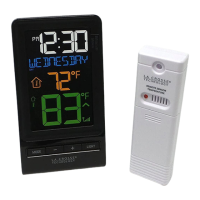

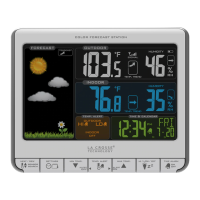
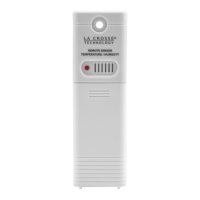
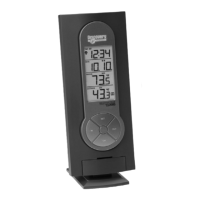
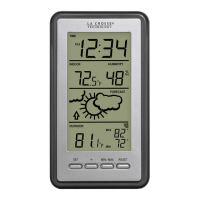

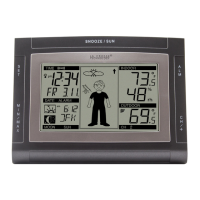
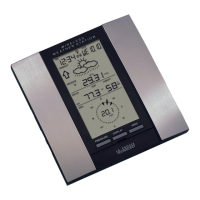
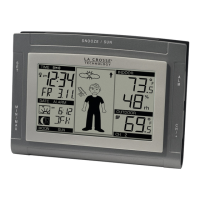
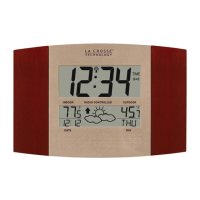
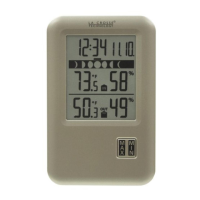
